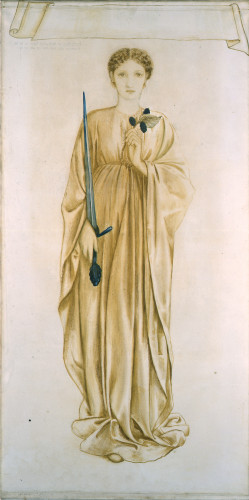This design is one of a number prepared by Edward Burne-Jones based on Geoffrey Chaucer’s ‘Legend of Good Women’, intended for an embroidered frieze for John Ruskin’s home. Burne-Jones had previously visited this subject in a series of tile panels produced for Morris & Co. in around 1861, and Morris himself had designed a series of wall hangings on the theme, intended for Red House, three of which are now located in the chapel at Castle Howard, North Yorkshire.
Here, Thisbe holds a sword and a mulberry leaf from the tree under which she is supposed to meet Pyramus, her lover. Before they can meet, she is frightened away by a ferocious lion, dropping her mantle as she flees. Pyramus arrives and, seeing the mantle, which has been torn and bloodied by the lion, he assumes the worst and kills himself with his sword. Thisbe soon returns to find her lover dead, and in her grief turns his sword upon herself.
The embroidery project was to be carried out by Burne-Jones’ wife, Georgiana, and the pupils of a girls’ school at Winnington Hall, Cheshire, run by Miss Bell, a friend of Ruskin. The work was never completed, however, as Georgiana remarked, “the joint embroidery scheme proved impracticable, and the drawings alone remained as a symbol of loving intentions”. These intentions did prove fruitful in the end, as the designs went on to be reused in stained glass windows made for The Hill at Witley, Surrey, of which six are now located in the Combination Room at Peterhouse College, Cambridge.

